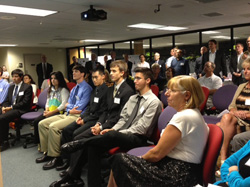By Jayna Miller
 The Chemical Engineering graduate program at UConn provides the opportunity for students to obtain a thorough understanding of the principles of chemical engineering and gain the practical skills needed to succeed in the workplace. Students have the chance to get involved in a number of useful research and teaching opportunities to better prepare for their future.
The Chemical Engineering graduate program at UConn provides the opportunity for students to obtain a thorough understanding of the principles of chemical engineering and gain the practical skills needed to succeed in the workplace. Students have the chance to get involved in a number of useful research and teaching opportunities to better prepare for their future.
Grad student Andrea Kadilak has taken advantage of many of the programs and activities that UConn had to offer. Her most rewarding experience during her years at the university was her involvement with the NSF GK-12 Fellowship Program, where she worked with high school students to inspire an interest in science.
“I worked with students at Windham Tech to raise awareness of career options in physics, chemistry, and engineering – I also showcased the fun side of science through experimental demonstrations,” she says.
In addition to the NSF GK-12 Fellowship, Andrea was also involved in a number of on-campus engineering groups. She is currently the Chairperson for the CBE Grad Student Association, and is the Activities Director for the local chapter of AIChE.
“These leadership positions provide an opportunity for me to plan events, network, and organize meetings that bring together all of the engineering programs at UConn, to create a collaborative atmosphere and provide a wide variety of research opportunities for students,” she says.
These positions were not Andrea’s first leadership and work experiences. Prior to attending UConn, she worked as a Process Engineer at Solutia for two years, but decided that she wanted to return to research in a university setting.
Andrea’s research currently focuses on the NSF EFRI Termite Grant, which involves working with a team of engineers, including CBE professor Leslie Shor, to simulate the termite digestive tract in a micro-fluidic device. Termites are able to efficiently break down cellulose and other woody materials into biofuels to use as a food source. Through this research, the team hopes to culture the digestive bacteria in the micro-fluidic device in order to observe it, and perhaps recreate the biofuels, which will have an environmental benefit because it can reduce fuel needs.
Andrea has received multiple accolades for her research at UConn. She received the Women’s Initiative Committee Travel Award at the Minnesota AIChE Meeting in 2011, and earned 2nd place in the Poster Presentation Competition. In addition, she was the recipient of an ACS Meeting Certificate of Merit in 2012.
In the future, Andrea hopes to work in industry, but also to continue her personal research. She enjoyed working in a chemical plant in the past, but would like to achieve a balance and bridge the gap between research and the implementation of research practices in a process.




 Republished with permission of UConn Today.
Republished with permission of UConn Today.

 The Department of Chemical & Biomolecular Engineering was the proud host of the 2014 Northeast Student Regional Conference for the American Institute of Chemical Engineers on April 4-5, 2014. The event attracted more than 300 undergraduate chemical engineering students from 21 schools, traveling from as far as McGill, Cornell and Maine, to as near as UMass and the University of New Haven.
The Department of Chemical & Biomolecular Engineering was the proud host of the 2014 Northeast Student Regional Conference for the American Institute of Chemical Engineers on April 4-5, 2014. The event attracted more than 300 undergraduate chemical engineering students from 21 schools, traveling from as far as McGill, Cornell and Maine, to as near as UMass and the University of New Haven.





 The Research Experience for Undergraduates (REU) program provides undergraduates with exposure to a stimulating research environment.
The Research Experience for Undergraduates (REU) program provides undergraduates with exposure to a stimulating research environment.
 The chemical engineering graduate program at the University of Connecticut is comprised of bright, innovative leaders who are motivated by change and challenge. The program offers the opportunity for students to enhance their skills and develop their potential.
The chemical engineering graduate program at the University of Connecticut is comprised of bright, innovative leaders who are motivated by change and challenge. The program offers the opportunity for students to enhance their skills and develop their potential.